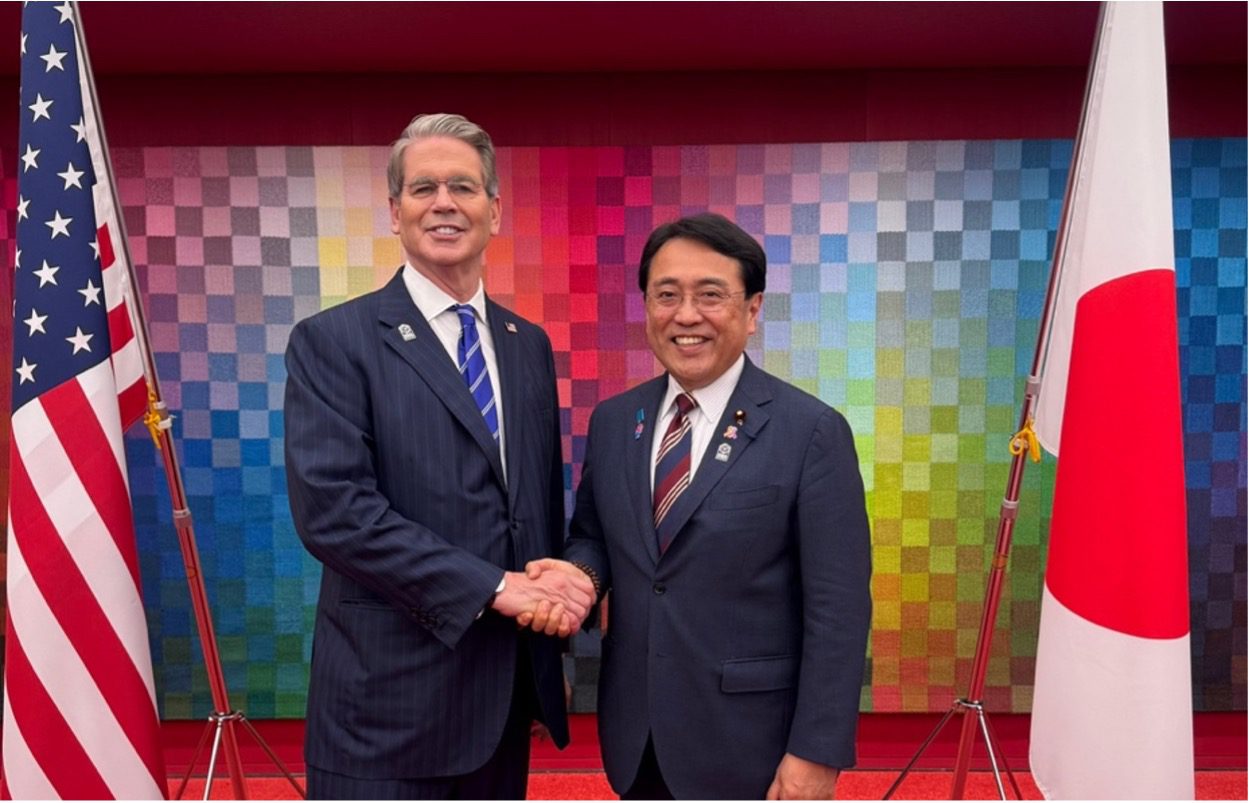U.S. Treasury Secretary Scott Bessent (left) and Japanese Minister of State for Economic and Fiscal Policy Ryosei Akazawa (right)
Source: X @ryosei_akazawa
The BGA Japan team, led by Managing Director Kiyoaki Aburaki, wrote an update to clients on Japan and U.S. tariff agreements.
Context
- U.S. President Donald Trump announced July 22 (U.S. time) that the United States reached a trade agreement with Japan. As part of the deal, Japan will expand imports of U.S.-made automobiles and agricultural products such as rice, and the United States will reduce its reciprocal tariff on imports from Japan — including automobiles — from 25 percent to 15 percent. Trump wrote on social media that Japan agreed to invest $550 billion in the United States. Speaking at a meeting in the White House with Republican lawmakers, Trump explained that negotiations with Japan had concluded successfully and that an agreement was also expected on a liquefied natural gas project in Alaska.
- Japanese Prime Minister Shigeru Ishiba confirmed the agreement July 23 (Japan time), telling reporters that the two sides had reached a consensus on the tariffs. He emphasized that the 15 percent rate is the lowest among countries running trade surpluses with the United States. Regarding rice, Ishiba said the existing duty-free quota of 770,000 tons under the “minimum access” framework would be maintained, while allowing for an increase in duty-free imports from the United States. He stressed, “We have protected what needed to be protected, while reaching an agreement aligned with the national interests of both Japan and the U.S.” As the minimum access framework remains unchanged, the impact on Japanese rice farmers is expected to be limited.
Significance
- The agreement is a boost to the Ishiba administration, but it does not erase the political damage from the recent election defeat. Currently, there is speculation that the Liberal Democratic Party will complete its review of the election outcome in August, after which Ishiba may announce his resignation. If so, a new party president would be selected by mid-September, followed by the appointment of a new prime minister later that month.
- Unlike past U.S.-Japan trade tensions, the U.S. reciprocal tariff measure is not directed exclusively at Japan, the fifth-largest U.S. import market in 2024. In this context, the relatively favorable 15 percent rate may help sustain the competitiveness of Japanese products in the U.S. market. The outcome has been met with relief in the automotive sector, where there had been speculation about a return to managed trade frameworks such as export quotas. If this stability holds, it could influence how businesses restructure their global supply chains.
Implications
- Businesses should take note of two key aspects of this positive surprise. The first is the potential need to reassess and reconfigure global supply chains, as Japan is now subject to a relatively low tariff rate compared to other countries. The second is the importance of fully capitalizing on the opportunities created by the enhanced bilateral cooperation on economic security.
- The bilateral agreement signals the strengthening of U.S.-Japan cooperation on economic security. Ishiba told the press Japan’s intent to deepen collaboration with the United States in strategic sectors such as shipbuilding, critical minerals and artificial intelligence, is in line with the new agreement. The Japanese government has already begun considering concrete steps to implement these initiatives. Businesses should actively engage with the government to position themselves as key players in these fields.
We will continue to keep you updated on developments in Japan as they occur. If you have any comments or questions, please contact BGA Japan Managing Director Kiyoaki Aburaki at kaburaki@bowergroupasia.com.
Best regards,
BGA Japan Team

Managing Director
Kiyo understands the Japanese business community inside and out from his three decades working for Japan’s most powerful business organization, Keidanren. He covers international trade and investment, defense and aerospace, information technology, entrepreneurship, deregulation and data privacy policy. He also played a leading role in developing and implementing political strategies for the private sector. Kiyo has led Keidanren’s strategic international initiatives since 2013, and most recently headed up the federation’s international engagement. He worked closely with former Prime Minister Yasuo Fukuda to establish Japan’s Track 1.5 dialogues with the United States and China. The dialogues produced important results by strengthening ...
Read More






















